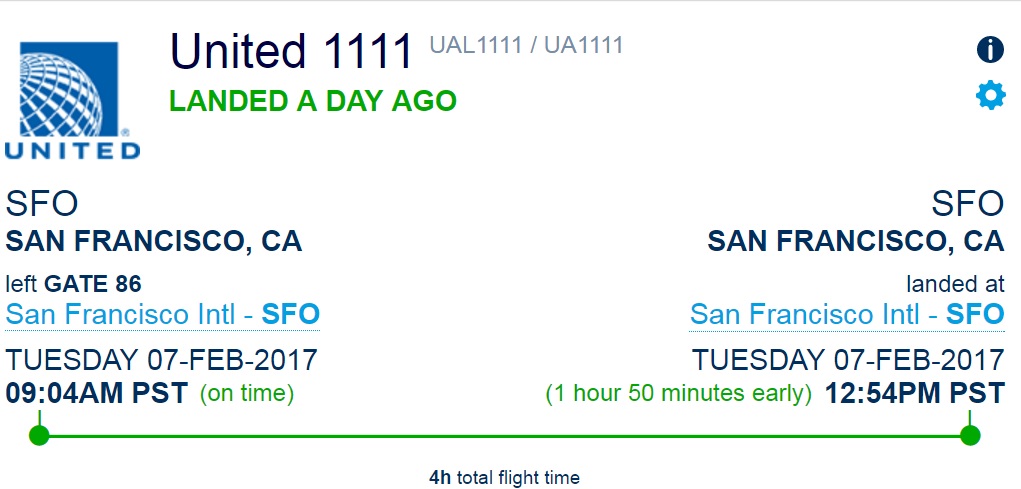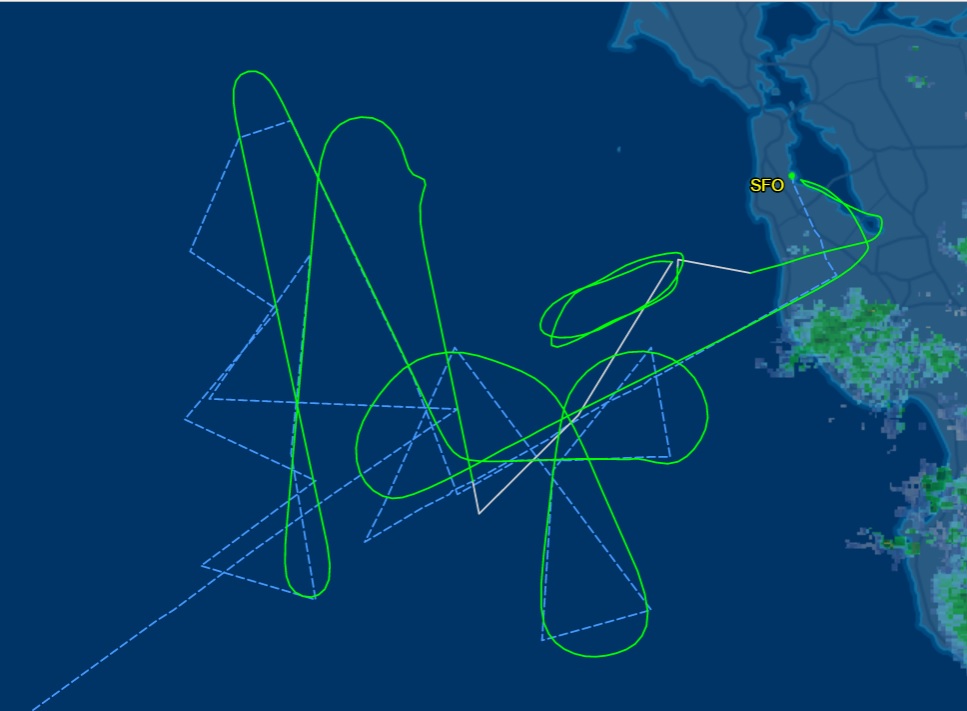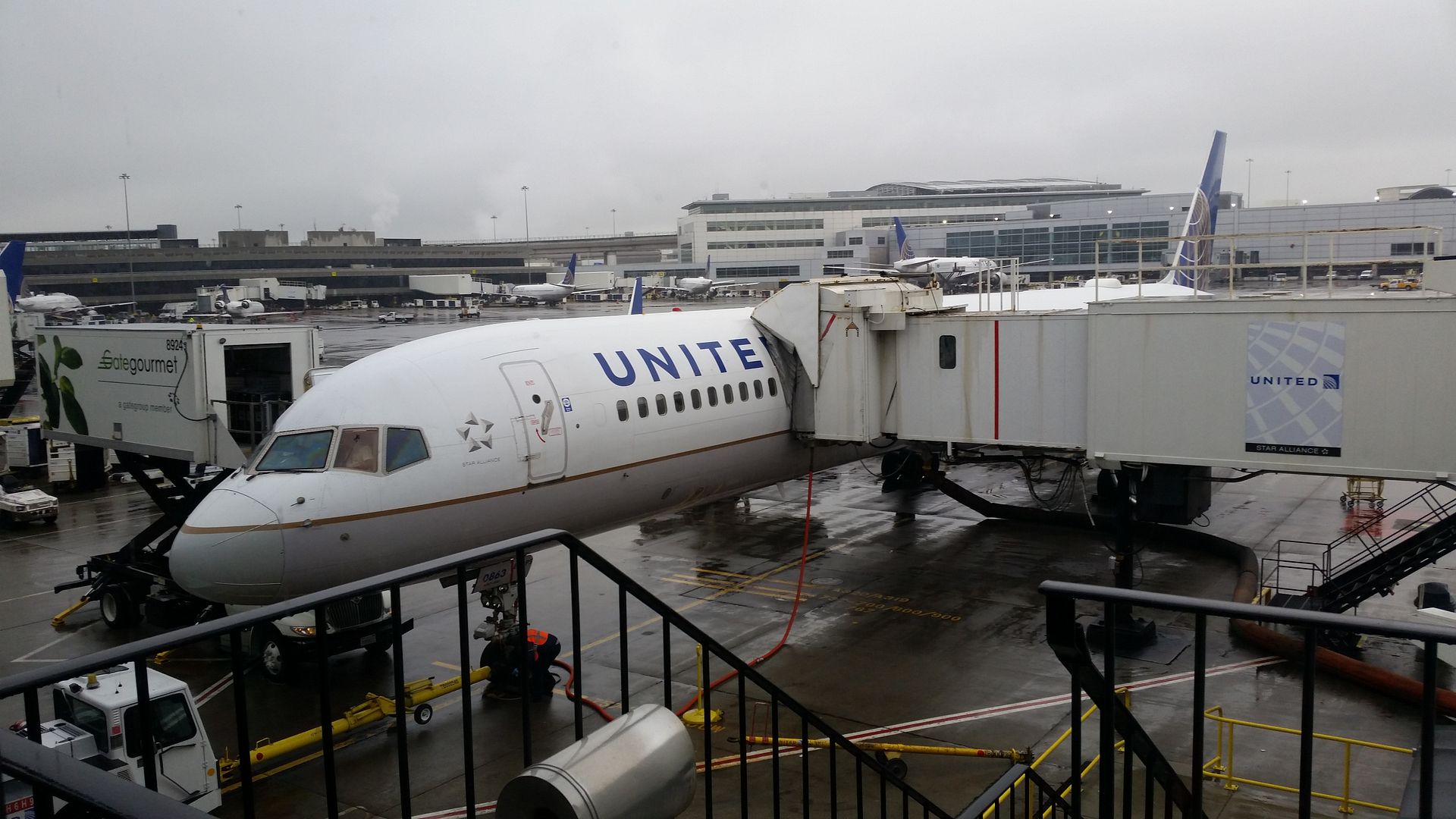You’ve probably heard of the Bridge to Nowhere and may have even heard of the Airport for Nobody but Travel Skills covers United’s 4 hour flight to no place.
United flight UA1111 on Tuesday was a four hour flight from San Francisco to San Francisco.

The flight was supposed to be headed for Lihue, Kauai. Instead it wound up circling over the Pacific for four hours and returning to San Francisco.
Here’s the flight path it took:

Chris explains what happened,
UA1111 departed on time at around 9 a.m., but experienced a maintenance issue shortly after take off which required a return to SFO.
To make it to Kauai safely (2,540 miles away), a Boeing 757 is loaded down with a LOT of very heavy fuel. It’s so heavy in fact, that the plane cannot land with that much fuel onboard.
In many cases like this, the pilots would quickly jettison the fuel at a high altitude. Once the fuel is offloaded, the plane could return and land. …However, a Boeing 757 is not able to dump fuel… this meant that pilots had to fly the plane in circles for four hours off the coast before returning

United Boeing 757 in San Francisco Waiting to Depart for Hawaii
United assigned another plane, took off around 4:30pm and made it to Hawaii around 9 p.m. about 8 hours late.


What sort of maintenance issue would be safe to fly for an extra 4 hours, but not the additional 2 to Hawaii?
(Also, what happens if there’s an actual emergency on a fully-fueled 757?)
They *can* land heavy, it just risks damaging the aircraft.
Only United
Gary, please see if you can get more of this story. The first comment above is very interesting and a good question. I’d love to know more details. Thanks.
@Jered — I assume the concern wasn’t so much about time in the air as distance from an airport had the maintenance issue gotten worse. Therefore, while the plane circled for hours, it never got that far from SFO. If the situation deteriorated further, the plane could have landed quickly at SFO (though risking damage because it would have been overweight). Obviously that’s not an option in the middle of the Pacific. What’s more, I have to believe that UA’s maintenance facilities are more extensive at SFO than LIH.
This is actually common. It happened to a EY plane just last month traveling from HKG to AUH, it circled for 4 hours outside HKG before returning to HKG. Is there a reason why this particular trip where a plane couldn’t dump fuel was worth an article but the other was not?
http://www.scmp.com/news/hong-kong/economy/article/2061335/etihad-flight-seeks-emergency-landing-hong-kong
I have the same first reaction as Jared in the first comment: It is intriguing to say the least that the plane couldn’t fly 6 hrs to Hawaii but was fine joy-riding over the Pacific for 4 hours!
Based on a previous experience (noted below), I would suspect that this had nothing to do with safety, but with some economic calculation.
That experience, many years ago, involved AA’s then-nonstop flight from Chicago to New Delhi, India. This was a 15 hour flight and with just a few hours left in it, it was announced somewhere above Central Asia that we were diverting to London, also a few hours away. For “safety reasons”; what else?
Of course this made sense to nobody, but they didn’t tell us more.
Later, it turned out that the crew had noticed a crack in the windshield. There was no immediate safety issue. The plane could have flown and landed anywhere its fuel would have allowed it to. However, once it landed, the airport regulators would not allow it to take off until fixed.
AA had only one daily flight to India and in their infinite wisdom had made no repair contracts in that country. If it landed at DEL, the plane would sit on ground for a few days till AA could get it repaired. In contrast, AA had a big operation at LHR and could turn that plane around quickly. So it was cheaper for them to put a planeload of pax into other flights (and many into hotels before that) than it would have been to have a plane sitting unused for a few days.
By the way, I am not suggesting that AA made a wrong decision in the above-noted case. Only that they didn’t tell us the real reason. It came out only in private conversations with he crew as well as AA’s staff at LHR.
there are some truly idiotic comments in this thread –
Circling off the coast of SFO is not the same as flying to Hawaii. Distance from diversion (or is this case origin) airport is what matters – not time in the air.
Having been to Kauai, I’m satisfied with “the repair facilities in SFO are better than the ones in LIH (if those exist at all)” answer, and that the failure could be something non-critical (like autopilot).
Oh Bob,
Thank you for being our column psychoanalyst and discovering some truly “idiotic comments.”
Good knowing someone is watching out for us.
The BIG asterisk here is that in the US passengers are entitled to NOTHING when this happens. Compared to EU, where this would’ve been a $650 p/p cash payment, that’s a joke.
As someone who gets air sick sometimes, just looking at that flight path makes me want to vomit…that would have been the longest 4 hours of my life!
Is it just me, or are there really some phallic symbols in that pattern?
I think Gary drew this
I can’t shake what a pilot once told me while I was awaiting a flight to Hawaii years ago: that airlines would never fly twin engine jets that far because if they lose an engine they are in mortal peril for literally hours over open water with no place to divert in the open Pacific.
Somehow this was rationalized out of common sense by increasing fuel loads without regard to what exactly would be done if an engine was lost and everyone onboard was unnecessarily put in mortal danger for 2-3 hours while returning or pressing on with only the single engine between them and ditching in the open Pacific which should be viewed as not survivable in spite of wishful thinking.
I can’t help but think that life has been devalued as part of this equation.
Wow, great operational performance by United to land almost 2 hours early!
@Greg: Was this more than 30 years ago? Because we’ve had ETOPS-180 for at least that long.
I think this is less “devalued safety” and more “jet engines are damn reliable”.
A350XWB is ETOPS-370 certified at launch!
But airliner safety eventually still comes down to redundancy and as of 20 years ago the idea of flying on only one engine in such a situation was too risky. It’s also the reason United kept flying 747’s 14 hours to Sydney, I believe, and now they leave huge planeloads of passengers at mortal risk in twin-engines with no diversion airport, only the unthinkable to land on waves that can be like mountains. The fact it hasn’t happened or the engines are 2000% more reliable doesn’t remove the possibility of disaster. Would you want to be on one of those planes where they gambled your life down to odds, no matter how odd? It seems like there’s a clear alternative – extra engine, at least when there’s no diversion within a risk windows that’s more than hours.
Looking at that map, makes me wonder. Who was the pilot? Mr. Toad?
Most likely there was a technical fault that wouldn’t allow them to enter ETOPS airspace. Due to the serious consequences of multiple failures a very high level of system redundancy is required before going further than 60 minutes from a suitable airport. All of these systems are checked prior to ETOPS entry and if there is a fault that can’t be rectified you have to divert or in very rare cases reroute on a non-ETOPS route. Systems that can routinely be on MEL domestically will take the aircraft out of ETOPS. No narrow body aircraft can dump fuel so unless there is an ongoing emergency you have to burn down to max landing weight.
ETOPS has been proven over several decades to be a safe and efficient way to fly over oceans and other large, undeveloped areas. The aircraft are maintained and operated to different, more rigorous standards than required for non-ETOPS fleets.
It’s my understanding that the reason needed to “dump fuel” or in this case “burn off fuel” is not so much about landing weight… it’s about “go around” weight. If the landing needs to be aborted (especially on short final), the plane must be quickly brought back into a departure configuration and have enough thrust-to-weight ratio to regain a climb.
So, the increased risk should the pilots have needed to return to SFO would have only been “go around not-possible”, not a damage from the excess weight.
Thanks for this. I think I will plan to avoid all jets that can’t safely dump fuel in future. Could you please list other jets that can’t dump? Flying around for hours with a serious problem doesn’t strike me as sane at all!
“Aircraft without fuel dumping capability are certified for overweight landing if necessary. Should an event occur requiring an immediate return for landing, the crew executes the landing and notes in the maintenance log that an overweight landing was made. The maintenance department conducts an inspection, and if there was no damage the airplane is released back into service.
“There is no safety tradeoff; this system has been used for decades successfully.
“John Cox is a retired airline captain with US Airways and runs his own aviation safety consulting company, Safety Operating Systems.” from USA Today, 2014
So- this wasn’t as scary as it sounds. In a real emergency, they could have landed.
@ Mr. Schwartz
Good point, if it was an engine out operation. However, being that the B757 took off from SFO with the fuel load, it is my guess that it is also capable of go-around performance based on no mention of a single-engine approach.
@clonedaddy — no, but there is in this one:
http://viewfromthewing.com/2015/03/17/a-pilot-drew-an-air-traffic-control-phallus-in-the-skies-on-thursday-and-now-is-famous-on-the-internet/
I think a friend was on this flight (unless this happened twice last week) and passengers were told it was indeed the autopilot.
Reminds me of a story where a United 767 ( or maybe a 777, I cant remember) flying from Hawaii to the mainland. Nearly halfway through the 6 hour flight they had to turn around and fly all the way back due after doing fuel calculations. Strong headwinds etc. Totally sucks.